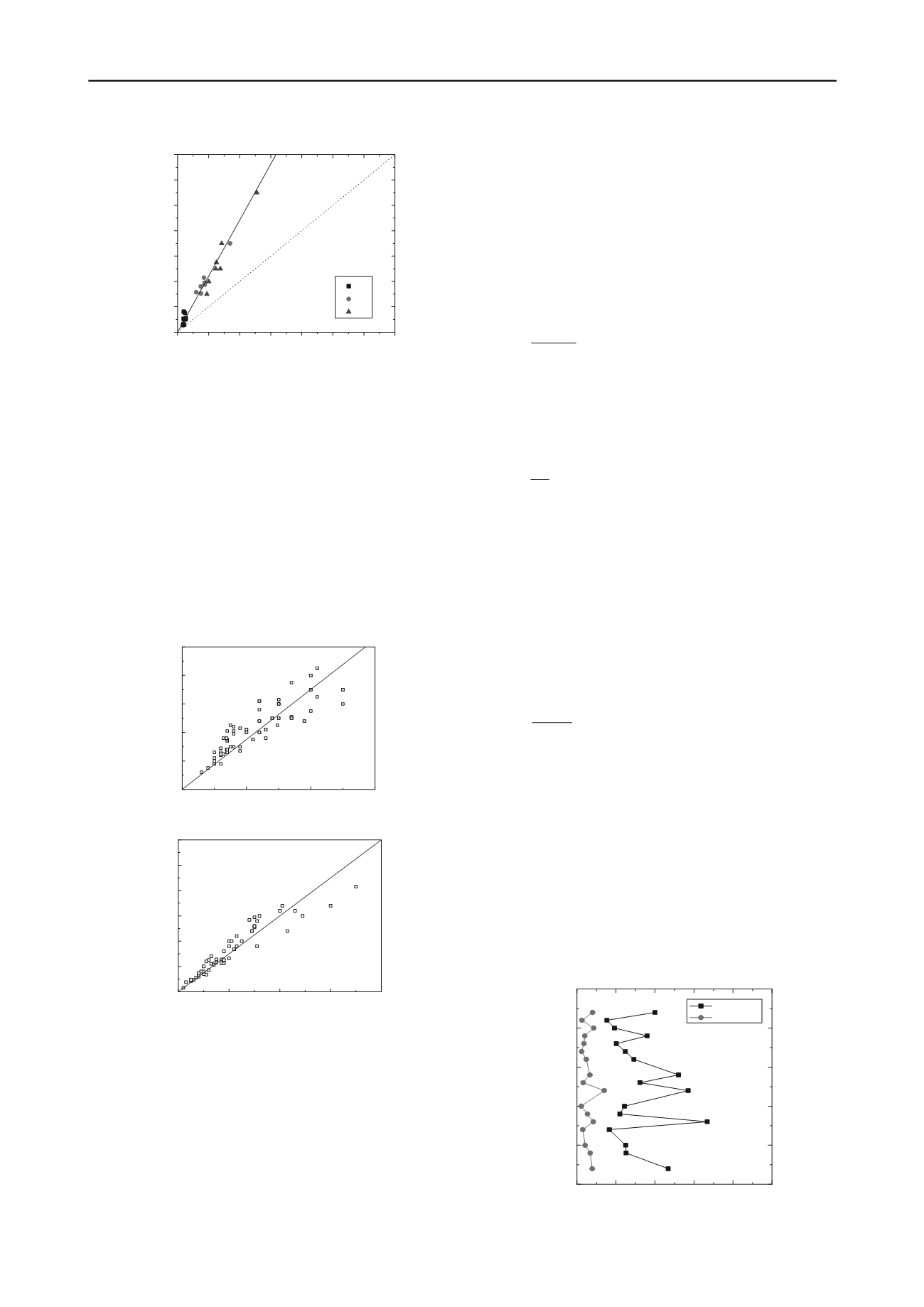
577
Technical Committee 102 /
Comité technique 102
0
4
8
12
16
20
24
2
0
4
8
12
16
20
24
28
8
Kulhawy and Mayne(1990)
M
-CPTU
=2.21M
-Lab
R
2
=0. 98
M -CPTU /MPa
M
- l ab
/MPa
CH
CL
ML
Figure 3. Measured versus predicted constrained modulus values
To examine the possibility for better correlations to estimate
the constrained modulus from CPTu data, the corrected cone tip
resistance (
q
t
) and the net cone resistance (
q
t
-
σ
vo
) were plotted
against the laboratory measured constrained modulus as shown
in Figures 4(
a
) and 4(
b
). A linear correlation was obtained
between M and qt as follows:
M
=3.36
q
t
R
2
=0.78 (4)
And the following linear correlation was also obtained
between M and (
q
t
-
σ
v0
) given as follows:
M
=3.73(
q
t
-
σ
v0
)
R
2
=0.92 (5)
The arithmetic mean and standard deviation of (M
-CPTU
/M
-
lab
) are 0.85 and 0.23 for the first correlation (
M
= 3.36
q
t
),
whereas 1.02 and 0.29 for the second correlation [
M
=3.73(
q
t
-
σ
vo
)].
0
1
2
3
0
2
4
6
8
10
Measur ed M/ MPa
q
t
/ MPa
M=3. 36q
t
R
2
=0. 78
(
a
)
0
2
4
6
8
0
5
10
15
20
25
30
Measur ed M/ MPa
( q
t
-
v0
) / MPa
M=3. 73( q
t
-
v0
)
R
2
=0. 92
(
b
)
Figure 4. (
a
)
q
t
~Measured M ; (
b
) (
q
t
-
σ
v0
) ~Measured M
3.3 Consolidation and permeability properties
Many theoretical and semi-empirical methods have been
proposed for deriving the coefficient of consolidation from
CPTu dissipation data. Teh and Houlsby (1991) proposed a
relationship between a dimensionless time factor and
c
h
value
based on numerical analysis of dissipation pore pressure with
the consideration of soil rigidity index parameter. Robertson et
al. (1992)
reviewed some dissipation data from piezocone tests,
and concluded that the predicted coefficient of consolidation by
Teh and Houlsby (1991) solution compared well with reference
values from laboratory tests and field observations. Schnaid et
al. (1996) and Danziger et al. (1997) showed that, when Teh and
Houlsby’s approach was employed to interpret various CPTU
results, the calculated values of
c
h
were of the same order of
magnitude as those measured independently in oedometer tests
in the laboratory. Abu-Farsakh and Nazzal (2005) compared
seven CPTU methods and showed that Teh and Houlsby (1991)
and Teh (1987) methods can estimate
c
h
value better than the
other prediction methods.
Teh and Houlsby (1991) proposed a relationship between a
dimensionless time factor and
c
h
value. The dimensionless time
factor,
T
*
,
is defined as:
5.0
2
*
r
h
I r
tc
T
(6)
where
c
h
= coefficient of consolidation in horizontal
direction;
r
= radius of cone, typically 17.85 mm;
I
r
= rigidity
index,
G/S
u
. Among the methods available for evaluating
c
h
from piezocone dissipation tests, the one proposed by Teh and
Houlsby (1991) is probably most widely used (Robertson et al.
1992). Teh and Houlsby’s (1991) equation is as follows:
2
50
50
r
t
T c
h
(7)
where the time factor
T
50
is related to the location of the
filter element and cone size. For a cone with a cross-sectional
area of 10 cm
2
and with a shoulder filter element,
T
50
= 0.245
(Teh and Houlsby 1991). The
t
50
is the measured time for 50%
dissipation. The method proposed by Teh and Houlsby (1991)
was used here to interpret the coefficient of consolidation for
the pore pressure dissipation curves in this study.
The coefficient of permeability in the horizontal direction
can be estimated from a CPTU dissipation test and by means of
the correlation factor (
k
h
/
k
v
) proposed by Jamiolkowski et al.
(1985). Baligh and Levadoux (1980) recommended that the
horizontal coefficient of permeability could be estimated from
the expression:
h
v
w
h
RRc
k
'
0
3.2
(8)
where
RR
= compression ratio in the overconsolidated
range, and can be obtained from the consolidation tests at the
corresponding stress level.
A comparison of the consolidation coefficient values
measured by CPTu dissipation test and laboratory oedometer
test is presented in Figure 5 in which the CPTU test measures
c
h
values, whereas the conventional oedometer test measures
c
v
. It
can be seen that the
c
v
values measured by oedometer test are
lower than the
c
h
values measured by CPTu tests. The
c
h
values
of the lacustrine clay measured by the CPTu tests are generally
4-6 times larger than the
c
v
values measured by the
conventional
oedometer
test,
indicating
anisotropic
characteristic of the soil.
25
20
15
10
5
0
0
1
2
3
4
5
Depth (m)
Coefficent of consolidation
(
10
-3 cm 2
/s
)
CPTU
Oedometer
Figure 5. Comparison of cv and ch profiles measured from CPTu and
laboratory tests


